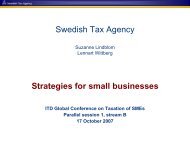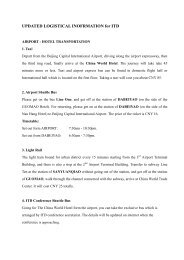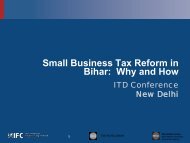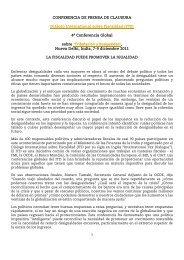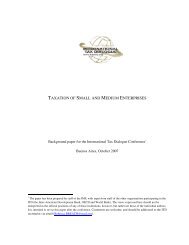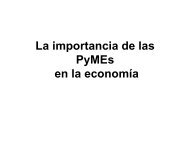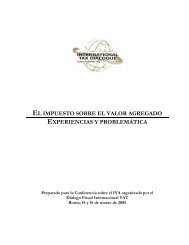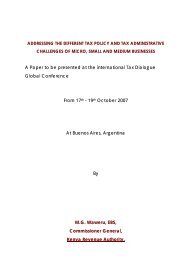Mr. Colin Clavey, World Bank/IFC - International Tax Dialogue
Mr. Colin Clavey, World Bank/IFC - International Tax Dialogue
Mr. Colin Clavey, World Bank/IFC - International Tax Dialogue
Create successful ePaper yourself
Turn your PDF publications into a flip-book with our unique Google optimized e-Paper software.
Session 2c<br />
TRANSFER PRICING<br />
LEGISLATION<br />
<strong>Colin</strong> <strong>Clavey</strong><br />
ITD Conference<br />
December, 2012<br />
Thailand
The average time<br />
for settling<br />
transfer pricing<br />
cases is about<br />
540 days<br />
Transfer pricing<br />
audits are easy<br />
to open, but<br />
difficult to close<br />
Personnel<br />
issues are<br />
crucial<br />
The stock of open<br />
cases tends to be high<br />
(in some cases 3-4<br />
times the average<br />
number of annual<br />
settlements<br />
Some countries recover<br />
very little from their<br />
transfer pricing audits,<br />
whereas others recover<br />
very large amounts<br />
from almost all audits<br />
There are examples of<br />
countries which have had<br />
transfer pricing<br />
legislation in place for<br />
some years - but yet not<br />
conducted a single audit
Transfer pricing rules…..<br />
• Ensure multinational enterprises pay the right amount of tax<br />
• Counter artificial cross-border profit – shifting and tax avoidance<br />
• May assist in countering capital flight<br />
• Create a predictable business landscape, which avoids double<br />
taxation or less than single taxation<br />
• Promote legitimacy of the tax system - where large and high profile<br />
taxpayers are known to avoid taxation, compliance among all<br />
taxpayers is discouraged, and the legitimacy of the tax system – and<br />
wider government institutions - is undermined
Are Transfer Pricing Rules Needed?<br />
• Value and pattern of cross-border trade<br />
• Level of MNE operations<br />
• Level of FDI<br />
• Evidence of “high risk” factors e.g. transactions<br />
involving low tax jurisdictions, artificial arrangements<br />
( See OECD’s “Country Risk Assessment” tool)
Are the basic building blocks in place?<br />
• Are companies required to maintain audited<br />
financial accounts?<br />
• Are companies subject to company income tax on<br />
their profits?<br />
• Is there experience in the country of auditing the<br />
returned profits of multinational enterprises?<br />
• Are there effective tax collection procedures in<br />
place?<br />
• Are there effective dispute resolution mechanisms<br />
(courts and appeal processes) in place?
Is there political and administrative<br />
commitment?<br />
• Is there political buy-in?<br />
• Is there resource availability to create a<br />
team of transfer pricing specialists?<br />
• Is there resource and willingness for a<br />
group of auditors to undergo specialist<br />
training?<br />
• Is there commitment to setting up transfer<br />
pricing management and oversight<br />
processes?
Other Considerations<br />
• Are other tax measures likely to have a more<br />
immediate impact? e.g. thin capitalisation<br />
rules and what resources are needed for these<br />
measures<br />
• Is there a case for limiting the scope of<br />
transfer pricing rules, or their<br />
implementation, in the early stages? E.g. to<br />
specific sector<br />
• Is there a case for introducing transfer<br />
pricing simplification measures for less<br />
complex or smaller transactions?
Key elements of a successful transfer<br />
pricing regime<br />
• Effective Primary legislation<br />
• Ancillary legislation: documentation; information<br />
powers; penalties; APAs<br />
• Formation of a specialist team<br />
• Development of specialist skills<br />
• Effective risk assessment and case selection<br />
processes<br />
• Effective audit processes<br />
• Effective audit governance procedures<br />
• Effective dispute prevention and resolution<br />
processes
TP legislation – key objectives<br />
• To require taxpayers to return a taxable<br />
profit in line with arm’s length terms<br />
• To allow tax authorities to make<br />
adjustments to returned profit where nonarm’s<br />
length terms have been used<br />
• To relieve double taxation??
Scope of legislation<br />
Rules generally apply to transactions<br />
between associated enterprises that<br />
take place cross-border.<br />
Is there a policy requirement to apply the<br />
rules to purely domestic transactions?<br />
And, if so, is a corresponding adjustment<br />
available?
How to define associated enterprises?<br />
• Enterprises are associated where one<br />
controls the other, or they are under<br />
common control.<br />
• How define control?<br />
• Dangers in defining too widely?<br />
“Sum of loans provided to the enterprise is greater than 50%<br />
assets”<br />
“Value of sales to, or purchases from, the enterprise is greater<br />
than 50% of turnover”<br />
.. Or too narrowly?
Aims of the legislation..<br />
Country A<br />
Country B – Low tax<br />
Trading Co<br />
Management<br />
Fees<br />
Management Co
Effect of legislation<br />
• <strong>Tax</strong>payers required to report an arm’s<br />
length measure of profit<br />
• Where they do not:<br />
- tax administration can make an<br />
adjustment to taxable profit.<br />
Adjustments are normally one-way only –<br />
to increase taxable profit
Testing arm’s length terms<br />
• 5 transfer pricing methods<br />
Other method if taxpayer can show it gives<br />
an arm’s length result.<br />
• Comparability – meaning and<br />
comparability factors<br />
Reference to international principles?
Primary v Secondary legislation<br />
Less flexibility?<br />
Less clear?<br />
Less tight?<br />
Legislation<br />
Regulations<br />
&<br />
Guidance
Primary v Secondary legislation<br />
More flexibility – can respond to specific<br />
issues<br />
Clearer<br />
Legislation<br />
Regulations<br />
&<br />
Guidance
Simplification measures<br />
• Exemptions for smaller taxpayers, and<br />
smaller transactions?<br />
• Administrative simplifications –<br />
streamlined APAs, reduced<br />
documentation requirements<br />
• Safe harbours
Ancillary rules<br />
• APAs<br />
• Documentation requirements<br />
• Return requirements<br />
• Information powers<br />
• Penalties



